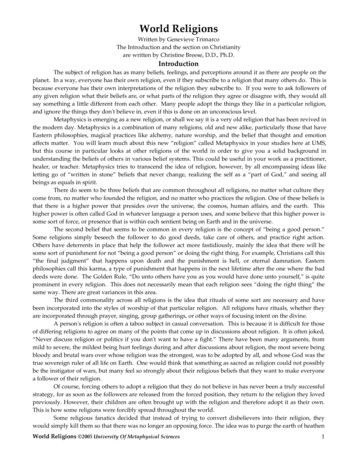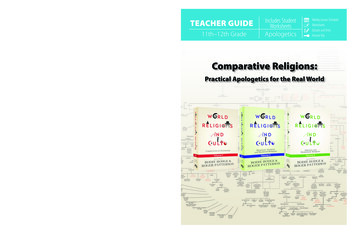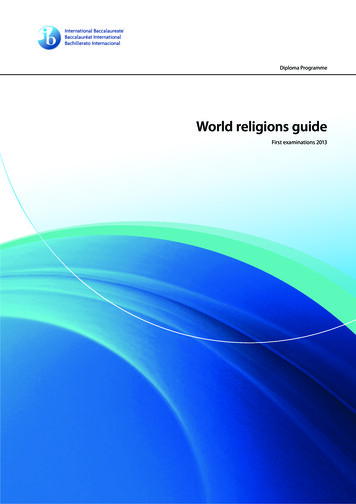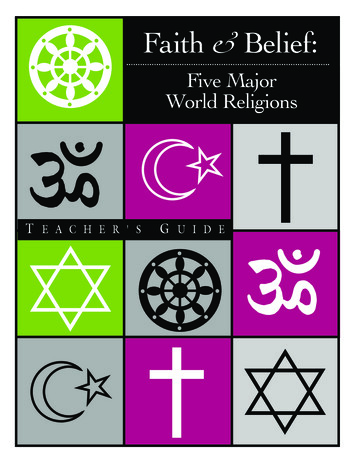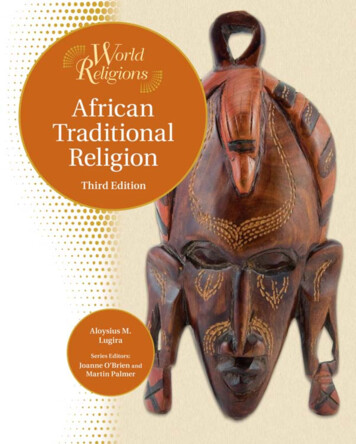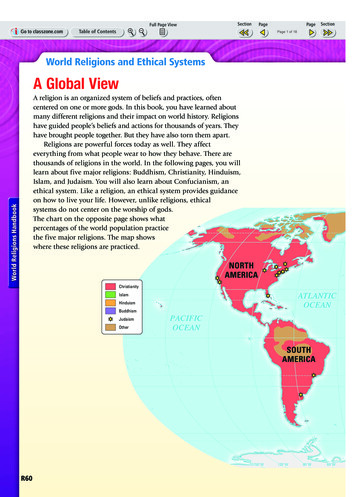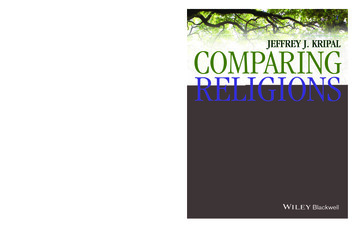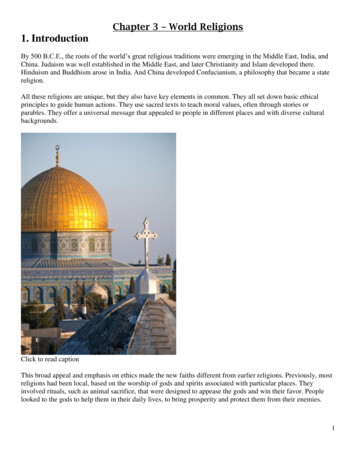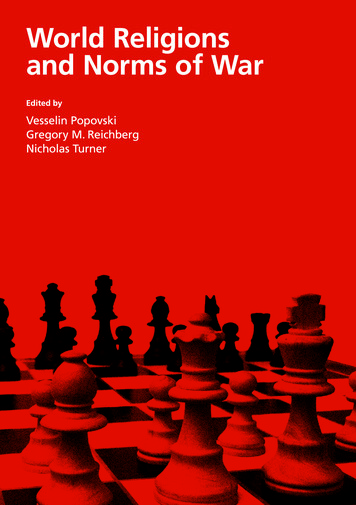
Transcription
World religions and norms of warEdited by Vesselin Popovski, Gregory M. Reichberg andNicholas TurneraUnited NationsUniversity PressTOKYO u NEW YORK u PARIS
ContentsAcknowledgements . . . . . . . . . . . . . . . . . . . . . . . . . . . . . . . . . . . . . . . . . . . . . . . . . . .ixContributors . . . . . . . . . . . . . . . . . . . . . . . . . . . . . . . . . . . . . . . . . . . . . . . . . . . . . . . . . . .xIntroduction . . . . . . . . . . . . . . . . . . . . . . . . . . . . . . . . . . . . . . . . . . . . . . . . . . . . . . . . . . .Vesselin Popovski11 Religion and war . . . . . . . . . . . . . . . . . . . . . . . . . . . . . . . . . . . . . . . . . . . . . . . . . .Vesselin Popovski112 Norms of war in Hinduism . . . . . . . . . . . . . . . . . . . . . . . . . . . . . . . . . . . . . . . .Kaushik Roy303 Norms of war in Theravada Buddhism . . . . . . . . . . . . . . . . . . . . . . . . . . .Mahinda Deegalle604 Norms of war in Japanese religion . . . . . . . . . . . . . . . . . . . . . . . . . . . . . . .Robert Kisala875 Norms of war in Judaism . . . . . . . . . . . . . . . . . . . . . . . . . . . . . . . . . . . . . . . . .Jack Bemporad1066 Norms of war in Roman Catholic Christianity . . . . . . . . . . . . . . . . . . .Gregory M. Reichberg142
viiiCONTENTS7 Norms of war in Eastern Orthodox Christianity . . . . . . . . . . . . . . . .Yuri Stoyanov1668 Norms of war in Protestant Christianity . . . . . . . . . . . . . . . . . . . . . . . . .Valerie Ona Morkevicius2209 Norms of war in Shia Islam . . . . . . . . . . . . . . . . . . . . . . . . . . . . . . . . . . . . . .Davood Feirahi25510 Norms of war in Sunni Islam . . . . . . . . . . . . . . . . . . . . . . . . . . . . . . . . . . . . .Amira Sonbol28211 Norms of war in cross-religious perspective . . . . . . . . . . . . . . . . . . . . .Gregory M. Reichberg, Nicholas Turner and VesselinPopovski303Index . . . . . . . . . . . . . . . . . . . . . . . . . . . . . . . . . . . . . . . . . . . . . . . . . . . . . . . . . . . . . . . . . .316
1IntroductionVesselin PopovskiWar is a rational choice, but there is always a desire from all sides to lookfor a certain ideology behind the rationality of war – to couple the pragmatism of decisions with various beliefs, principles or dogmas. With theend of the East–West ideological confrontation, attempts have beenmade to review the sources and nature of conflicts. Samuel Huntingtonfirst proposed the idea of a ‘‘clash of civilizations’’,1 arguing that, withthe demise of Communism and the end of the Cold War, conflicts willemerge along the dividing lines of national, ethnic or religious groups, ineffect bringing religion back as an ideological causa belli. Inter-religiousor ‘‘holy’’ wars existed for centuries before Huntington. Scholars debatedwhether the Crusades were about religious supremacy, or whether the‘‘holy’’ warriors used – or, rather, abused – the name of God for materialinterests, such as grabbing foreign land.2 Some challenged Huntingtonfor simplifying the causes of conflicts, and argued that civilizational identities are not necessarily solid foundations, that there could be official andunofficial, orthodox and unorthodox civilizations.3Today, more people in more countries exercise individual freedom ofexpression and decide independently whether to identify themselvesthrough ethnic or religious characteristics or to resist predeterminedaffiliations.4 Yet many violent conflicts – Kashmir, Northern Ireland,Bosnia, Kosovo, Chechnya, Darfur and Iraq – have been presented asinter-religious conflicts, and have generated discussions about how religious traditions would justify wars between states, and rebellions withinstates. Recent terrorist attacks, carried out all over the world – inWorld religions and norms of war, Popovski, Reichberg and Turner (eds),United Nations University Press, 2009, ISBN 978-92-808-1163-6
2VESSELIN POPOVSKIMoscow, New York, Colombo, Bali, Madrid, Istanbul, London, Mumbaiand Algiers, among others – by organizations claiming religious motivations, have raised further questions about religious attitudes to violence.To understand how religion and violence are connected, one must look atthe original religious texts and at the subsequent teachings and interpretations within religious traditions. A fresh analysis of when and howworld religions justify the use of force is necessary in order to avoid oversimplification in the explanation of recent conflicts, terrorism, asymmetricwarfare, genocide, ethnic cleansing and crimes against humanity. The importance of examining such issues arises from the fact that religions continue to be the foundations of human civilization – the central anchors ofhuman consciousness, motivation and behaviour.This book results from a joint research project conducted by the UnitedNations University (UNU) in Tokyo and the International Peace Research Institute in Oslo (PRIO). It brings together theologians and historians with in-depth knowledge of religious traditions, who wereapproached and asked to research and write original chapters on howthe world religious traditions address specifically the issues of justificationof war ( jus ad bellum) and methods of warfare ( jus in belli). Many bookson religion and war have been written by Western authors. A distinctfeature of this book project is that it assembles scholars with deep rootsin each tradition. We consciously aimed to create more direct access tothe internal debates within the traditions and channel these debatestowards jus ad bellum and jus in bello considerations. Our book is dedicated both to exploring the historical roots and interpretations of all themajor traditions and to linking them to the challenges of modern warfare.An essential virtue of this book is that all the authors have profound expertise in their religions and they are both intellectually and emotionallyengaged in the debates.The book reflects on many historical texts and demonstrates how theworld religions distinguish between offensive and defensive war, howthey address principles such as necessity, proportionality, right causeand right purpose, and discrimination between combatants and non-combatants. The book avoids judgements; it does not apply labels such as‘‘right’’ or ‘‘wrong’’, and it is not interested in generalizations aboutwhether the modern world can be characterized as a ‘‘clash’’ or as an ‘‘alliance’’ of civilizations. The authors focus on each religion separately andavoid confrontational comparisons. Readers can obviously find similarities and analogies that manifest certain harmonies between the religiousand ethical perspectives and also the distinctive features of particular religions, demonstrating their diversity. The book does not aim to classifywhich religion is more permissive or more prohibitive towards the resortto force, but rather aims to look at the variety of sources and interpreta-
INTRODUCTION3tions of just causes and permissible instruments of warfare. Another challenge is that the chapters explore hundreds, and even thousands, of yearsof the evolution of each tradition, at various times subjected to splits andunifications, progressions and regressions. Sunni and Shia Islam; Catholic, Orthodox and Protestant Christianity; Theravada Buddhism; Japanesereligion; and Hinduism all have historical connections and disconnections, dialogues and antagonisms. The authors re-emphasize both thepacifist and the belligerent messages of the religions, detailing various interpretations and misinterpretations, uncertainties and deliberate abusesof religious texts made for policy-driven purposes.In addition to this comprehensive historical outlook, this book intendsto illustrate how religions respond to modern developments – the creation of international regimes and organizations (such as the UnitedNations) – as well as to assess recent armed escalations (such as that inLebanon in August 2006). As the chapters unfold, the realities of originand interpretation, fairness and injustice, legitimacy and illegitimacy,among others, surface and lend reason to rethink the intertwined natureof religions and norms of war, to demonstrate and analyse how religiousteachings engage in norm-making. Looking at the norms of war from theperspective of religious literature helps to understand modern threatsto peace and security and the responses to these threats, including – inextremis – the use of military force. To summarize, the main objectiveof this book is to present the evolution of the norms of war in the worldreligions.The order of the chapters is sequenced chronologically. The first religion to be featured is Hinduism, as its extant writings reach further backin time than the other traditions. The book then reflects the fact thatBuddhism developed from Hinduism, and Christianity and Islam fromAbraham/Judaism. To maintain this chronological approach strictly, onewould have included Judaism second after Hinduism, but the orderchosen also attempts to group together the religions of the same broadfamily: Hindu–Buddhist, Judaeo-Christian, and Islamic.Kaushik Roy’s chapter analyses the role of Hinduism in shaping theethics and dynamics of organized violence in India and presents theHindu religion as a key factor in the evolution of Indian military strategies. He examines the ambivalent relationship between religion and violence, arguing that, in comparison with the Western world’s attempts tosecularize warfare, religion is crucial in the understanding of the natureof warfare in many parts of Asia, where violence remains the moral essence of the warrior. His analysis challenges the view that Hinduism is agenuinely pacifist religion, showing that the rejection of warfare is only amarginal and comparatively recent trend, whereas the realist view of warhas been highly respected for centuries. Apart from Gandhi, none of the
4VESSELIN POPOVSKImajor Hindu theorists spoke about non-violent resistance. Roy demonstrates that, in fact, in Hinduism the norms of war, not pacifism, have historically introduced humane principles, reducing the lethality of war andmoderating the effect of warfare on non-combatants. The chapter is amodel demonstration of how historical analysis can help to understandmodern political options, and concludes that even today the Indian rulingelite’s consciousness continues to be shaped by traditional philosophies.It is the Hindu religious texts, rather than the teachings of Hindu priests,that have influenced warfare.Mahinda Deegalle’s chapter offers a valuable comparative study ofthe teachings of Buddha, the Theravada traditions and those of theirMahayana alternative. It addresses the contradiction of being Buddhistand engaging in war, asking crucial questions such as: Can Buddhism justify a war? Can Buddhists join an army? If so, what happens to theirBuddhist identity? How can states with a majority Buddhist populationmanage war situations? What is the role of Buddhism in such situations?Deegalle reveals the various sources of Buddhist traditions, and naturallyfocuses on identifying the conceptualization of war and the use of force inthe Theravada Buddhist tradition of Sri Lanka, a country still ravaged byviolence. The chapter offers additional value and relevance in understanding the contemporary conflict by asking whether violence is justifiedto protect the state. Deegalle explores both historical and contemporaryinterpretations and demonstrates how, both in theory and in practice,war is largely incompatible with Buddhist teachings and the Buddhistway of life, and how therefore the war in Sri Lanka is an enormous challenge to the way fundamental Buddhist teachings and practices havebeen developed and communicated.Robert Kisala’s chapter explores the influence of the Buddhist andShinto traditions on war and peace in the context of Japanese history.Insofar as prior to the twentieth century Japan was involved in very fewinternational armed conflicts, the most important influence on the premodern Japanese concept of peace was the experience of internal conflictand internal social order. The situation changed at the end of the Tokugawa era, when universal conscription was introduced by the Meiji regime and a national army created. Japan went to war with China in 1894over spheres of influence, gained Taiwan as a colony, later fought Russiaand was granted privileges and control of Manchuria. With the annexation of Korea in 1910 and by allying itself with European forces fightingGermany in World War I, Japan was able to expand its territorial control. It was in this context that Western pacifist and ‘‘just war’’ ideas entered the intellectual and public discourse in Japan, assisted largely bythe activities of several Christian missionaries. Kisala shows how the defeat in World War II, the postwar occupation and, especially, the destruc-
INTRODUCTION5tive use of atomic weapons have shaped Japanese attitudes towards ‘‘pacifism’’, in particular the presumption against the use of force and the renunciation of war in Article 9 of the Constitution. Along with pacifism,Kisala identifies a second characteristic of the Japanese religious conceptof war and peace and calls it ‘‘civilizational morality’’ – a unique Japanese concept with a dual emphasis on individual moral cultivation and,at times, an oppositional schema derived from a sense of cultural superiority. The idea of ‘‘civilization’’ emphasizes the active pursuit of individual moral edification, leading to a refined, civilized state of the being. Itcan lead to a conceptual distinction between ‘‘civilized’’ and ‘‘uncivilized’’ regions, which in turn can result in a cultural mission aimed atspreading the benefits of ‘‘civilization’’ as they are enjoyed in one’s ownregion. Kisala finds commonality between Japanese and Western usageof the ‘‘civilizational’’ mission to justify, or at least inspire, military andcolonial conquest.The book then turns to the three Abrahamic monotheistic traditions: achapter on Judaism by Jack Bemporad; three chapters on Christianity –Gregory Reichberg’s on Catholicism, Yuri Stoyanov’s on the Orthodoxtradition and Valerie Morkevicius’ on Protestantism; and two chapterson Shia and Sunni Islam, respectively by Davood Feirahi and Amira Sonbol. Again, the order of these chapters follows the historical chronology,starting with the oldest tradition and finishing with the youngest.Jack Bemporad recognizes that the Jewish tradition does not operateexplicitly with the just war categories of jus ad bellum and jus in bello,but shows how many discussions in biblical and rabbinical sources engagein very similar considerations. One can categorize certain Jewish statements as contributing to right reasons for going to war and the right conduct of war. What is significantly different between these principles inJudaism and just war theory is the Jewish belief that war is not a naturalcondition and that universal peace can be a reality. The biblical and rabbinical sources are concerned with peace more than with war, even if theOld Testament contains stories of brutal mass slaying. Bemporad, similarly to the other authors, makes a brilliant cross-century historical voyage, arriving at the current state of affairs. He argues that Israel as aJewish state cannot forsake the task of explaining its existence and behaviour in terms of Jewish tradition and heritage, and thereby in universal ethical categories. If Israel were a secular nation-state, it wouldrespond in terms of realpolitik and ethics would apply secondarily, if atall. The dilemma becomes complicated with the issue of asymmetric warand with the post-Holocaust imperative of survival. Asymmetric warfareevolved gradually and the rift between political and religious factorsdeepened. The concepts of restraint and purity of arms, developed inthe 1930s by what later became the State of Israel, were constantly under
6VESSELIN POPOVSKIreview, and the protection of enemy non-combatants in modern warfarehas increasingly been called into question, owing to weapons of mass destruction, guerrilla warfare, terrorism and suicide bombing. Also important in the historical heritage is that many Holocaust survivors witnessedhow millions of Jews, predominantly non-combatants, were marked fortotal extermination. The inhuman Nazi ideology – which not many couldpredict at the time – led to real and duly implemented genocidal policies,which the League of Nations and governments could not stop. As a result, Israel still lives with a ‘‘siege mentality’’ and the great challenge, asBemporad ascertains, is how to preserve the original Jewish ethics whenit comes to modern methods of warfare.Gregory Reichberg presents the ethics of war in Catholic Christianity,where the substantive origins of the just war theory can be found. Reichberg describes four approaches – pacifism, just war, perpetual peace andregular war – and comprehensively analyses the changing tendencies anddynamics in different historical contexts over the centuries. He demonstrates that these four approaches have not developed in isolation andthat various elements of them have frequently been integrated into theoutlook of the same Catholic thinkers. This interconnectedness accountsfor much of the complexity and richness of the just war theory within thetradition, adding an important element of right authority into the rightcauses and aims of war. Reichberg also shows how early Catholic convictions – such as those of Ambrose and Augustine – that war could bewaged only for the maintenance of a just peace gradually developed intoa main normative concept against which any resort to war was to be measured. As a result, motives of personal gain, power, territorial aggrandizement and economic reasons were explicitly excluded from the list ofjustifiable causes of war. Despite the richness of the early teachings, theactual just war theory did not arise until many centuries later, when thecanon lawyers such as Gratian sought to organize early texts on war andviolence – passages from the Bible, statements by Augustine, enunciations of church councils, formulations from ancient Roman law – into anarticulated doctrine. Focusing on jus ad bellum, the chapter is comprehensive in both scope and time, exploring developments of the Catholictradition up to the present day, discussing the role of the just war in shaping the prohibition on the use of force in the League of Nations and inthe UN Charter, and examining recent messages from the Vatican, citingpapal references to the humanitarian intervention in Kosovo.Yuri Stoyanov’s chapter undertakes a huge, almost impossible, task –to analyse attitudes of the Eastern Orthodox Church toward the use ofarmed force and methods of warfare. Most texts have remained unpublished or untranslated into English, but even those published have not received anything like the same degree of scholarly attention as parallel
INTRODUCTION7developments in Catholicism and Protestantism. Accordingly, this is anoriginal and impressive chapter, assessing and bringing into the publicknowledge many texts that have been largely unknown until now. Thecomprehensive historico-academic journey is structured, similarly to theprevious two chapters, through the trichotomy of pacifism, just war andcrusade as the main characteristics of Christian attitudes to warfare.Stoyanov discovers that the formation of religious-national ideologies inOrthodox Eastern Europe has led to the emergence of what can be defined as elements of crusading along with the traditional presence of pacifism and just war. The historically prevalent pacifist Eastern Orthodoxstance has recently been categorically reiterated by Ecumenical PatriarchBartholomew and a number of senior Orthodox ecclesiasts. Stoyanovmakes some other significant findings – for example, that the 2000 JubileeCouncil of Russian Bishops’ Statement of Faith advances a rare exposition of a systematic Orthodox just war tradition. Although the Statementbegins with an explicit emphasis on the Orthodox view of war as unconditionally evil, caused by hatred and human abuse of God-given freedom,it also identifies the cases in which war may be necessary, such as selfdefence, defence of neighbours and ‘‘restoration of trampled justice’’. Italludes to cases in which national saints and churchmen have blessed defensive wars against invaders. To justify the resort to war in these instances, the Statement reproduces episodes of the church’s high respect forthe Christian virtues of soldiers who follow the precepts of a just war,and rewards them by canonizing them as saints. It also uses scripturalreferences to characterize the Orthodox teachings of jus in bello norms –a topic that was largely ignored in earlier Eastern Orthodox texts andspeculations on justifiable warfare. Stoyanov also provides an in-depthexposition of the Orthodox concepts of peace, with the Russian Church’scommitment to peace-making and its dedication to opposing propagandaof war and violence. He shows that the military conflicts in the formerYugoslavia, the former Soviet Union and the Middle East have compelled Orthodox clerical circles as well as theologians and historians toaddress the moral problems related to the justification of modern warfaremore systematically. In a public statement from 1991 in relation to thefirst Gulf War, the Holy Synod of Bishops of the Orthodox Church inAmerica declared that just war theory does not reflect the Orthodoxtheological tradition, which maintains that war can never be theologicallyjustified. Accordingly, questions have been asked whether WesternChristian-style just war systems can really be appropriate for the Orthodox Church. Stoyanov concludes that modern Orthodox thought cancertainly draw on a rich heritage of theological and ethical views to stimulate such reconceptions.Valerie Morkevicius’ chapter follows naturally by describing how the
8VESSELIN POPOVSKIProtestant Christian tradition has contributed to the development of thenorms of war. Morkevicius analyses five broad groups of historical origin:Lutheran, Calvinist, Anglican, Evangelical and Anabaptist. The first threeand their successor churches, she affirms, uphold a traditional view of justwar theory inherited from their Catholic predecessors. Morkeviciusargues that these Protestant groups elevated the just war theory to aneven higher position than under the Catholic tradition. It is important tonote that within each of these divisions there are numerous independentgroups, which in terms of practice may differ greatly and may not evenrecognize each other as members of the same family. Denominationsassociated with the first three traditions – Lutherans, Calvinists andAnglicans, as well as their daughter churches – have often been themain state churches or the most dominant forces within their societies.Evangelicals – a very loose grouping of denominations and sects – alsooften locate their historical roots in one or more of these three traditions.For this reason, their beliefs about war are as highly varied as theirorigins. The Anabaptists, with a few exceptions, primarily consist of denominations known as ‘‘peace churches’’, which uphold a pacifist doctrine. Morkevicius examines the evolution of three dominant approacheswithin Protestantism: pacifism, realism (or crusading) and just war. Ofthese three, she maintains that the just war approach has received themost attention. One explanation could be that the denominations thatfollow the just war approach have been more dominant in political, socialand demographic terms, and more connected to the power of kings, emperors and colonizers.Last, but not least, the two chapters on Islam by Davood Feirahi andAmira Sonbol present the views of Shia and Sunni Islam as a culminationof the monotheist Abrahamic traditions. Over many centuries, Islamiccommunities have developed norms and traditions pertaining to war andpeace that can generally be referred to as Islamic ethics of war. TheQur’an and Hadith literature, the jurisprudence, politics and decisionsnecessitated by historical events, and the theological interpretations ofwar made by religious and political leaders have all contributed to Islamic war ethics.Davood Feirahi offers a detailed assessment of the concept of jihad inthe traditional Shiite jurisprudence, in which ‘‘offensive’’ war may bewaged only at the command of an infallible (twelfth) Imam. The viewthat jihad cannot be conducted in the absence of instruction by an infallible Imam is in effect a prohibition on, or at least a suspension of, offensive warfare. In contrast, ‘‘defensive’’ jihad is permitted: if Muslims areattacked by an enemy or if the religion and lives of Muslims are in danger, the defensive war is a religious duty even under an unjust ruler. Feirahi outlines the various levels of self-defence in Shiite Islam, starting with
INTRODUCTION9non-violent opposition; then requesting help from others; and, if theseare unsuccessful, the use of coercive sanctions, from simple, to more sophisticated, to confronting the enemy. These strategies aim to stop theaggression but, if the aggressor does not withdraw, then he, free or slave,Muslim or unbeliever, deserves death. The defenders shall be consideredmartyrs if they are killed in the process. These norms are valid only if theaggressor does not flee or cease fighting. If the aggressor stops and withdraws, any further harm should be avoided or compensated. This is in effect the genesis of the norm of protection of surrendered soldiers andprisoners of war. Feirahi also presents other norms of jus in bello: theprohibition on ‘‘cursing an enemy’’, and on the use of terror or deceit inwarfare. Traditional Islam can be seen as the developer of the modernprohibition on weapons of mass destruction – it introduced the prohibition on poisoning water or the air. Even during defensive war, any useof weapons other than those absolutely vital is not permitted; if heavyweapons are used when there is no need, Islam demands punishment ofthe user.Amira Sonbol undertakes a comprehensive overview of Islamic teachings on war with a special focus on the Sunni tradition. She argues that,notwithstanding the widespread belief among Muslims that key Sharianorms of war derive directly from the teaching of Prophet Muhammad,Islamic ethics have evolved significantly over 14 centuries of history sincethen. Even today, Islam continues to evolve in different directions. Sonbol makes the challenging argument that various groups, including themost radical, find fertile ground for their advancement by following theIslamic belief in an unchanging and absolutist framework for righteouswar. She explains how deconstructing the discursive history of the ethicsof just war in Islam is one way of illustrating the contradictions betweenwhat Islam is purported to say and how various political groups interpretIslam and act accordingly. Islam incorporates basic principles commonamong major religions, such as the protection of civilian life, respect forhuman dignity and opposition to aggression, from earlier traditions. Protecting human life is the first command of the Qur’an and the first lessontaught to Muslims; life is a valuable gift from God. A close second is protecting the vulnerable and the helpless; the Qur’an and Hadith demandthat warriors feed orphans, take care of wayfarers, and protect them inevery possible way. Sunni Islam also demands special care for the elderly,women, children and the disabled – in effect, all vulnerable people whomay suffer during war. Among the latter group would also be nonMuslims who do not participate in war. The wounded among enemy warriors also fall within the category of the helpless; extending medical service to them, even if they previously participated in battle, is an essentialpart of Islamic war ethics and fits with its ultimate purpose of protecting
10VESSELIN POPOVSKIlife. Sunni Islam also advocates the fair treatment of prisoners who areunarmed and therefore rendered helpless. All these Islamic protectionsrepresent the source and the model for the later codification and development of international humanitarian law in the Hague and GenevaConventions. In the same vein, the poisoning of water-wells is stronglyforbidden in Sunni Islam, as is the poisoning of food supplies and the destruction of homes, animals or agriculture as methods of war. Also forbidden are outright massacres and punitive punishment meted out to thekin and tribes of enemies. Even a punitive war, or a war to take backwhat has been usurped, must be limited as precisely as possible and directed at the enemy who waged war against a peaceful community. Sonbol’s assessment helps to orient and explain many contemporary issues,including the fact that Islam has nothing to do with al-Qaeda’s pretences.The book essentially documents how the world religions have developed various norms of war, but all the chapters, in addition to addressingthis main task, maintain their own choice of historical texts, issues andspecific focuses and can be read as independent individual assessments.Religions have often been ignored or reduced to stereotypes by socialscientists and military strategists, who prefer to look at war as a rational,pragmatic exercise. This book comes as a necessary correction. It showsthe richness of the cultural and religious parameters of war and arguesthat both the mind and the heart, both reason and emotion, are instrumental elements of when and how to fight.Notes1. Samuel P. Huntingdon, The Clash of Civilizations and the Remaking of World Order.New York: Simon & Schuster, 1996.2. Christopher Tyerman, God’s War: A New History of the Crusades. London: Allen Lane,2006.3. For example, Edward W. Said, ‘‘The Myth of the Clash of Civilizations’’, lecture delivered at the University of Massachusetts, 1998. Said advocated an alliance of civilizationsand a coexistence of differences.4. See Amartya Sen, Identity and Violence: The Illusion of Destiny, Issues o
The book reflects on many historical texts and demonstrates how the world religions distinguish between offensive and defensive war, how they address principles such as necessity, proportionality, right cause and right purpose, and discrimination between combatants and non-com-batants. The book
